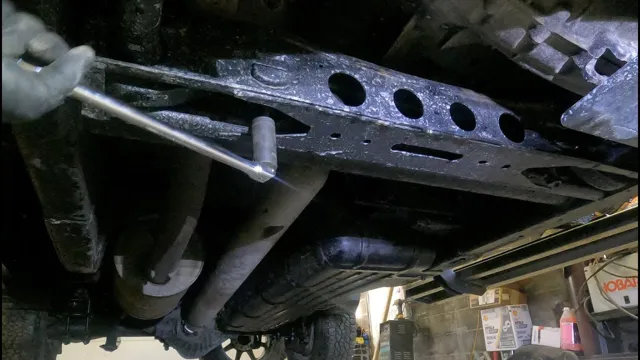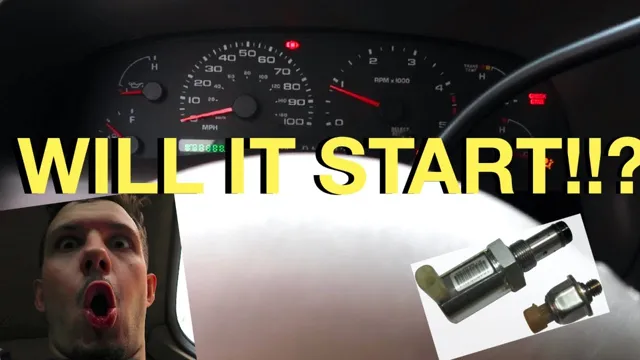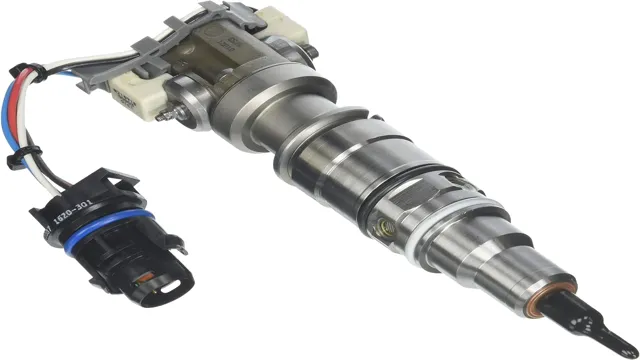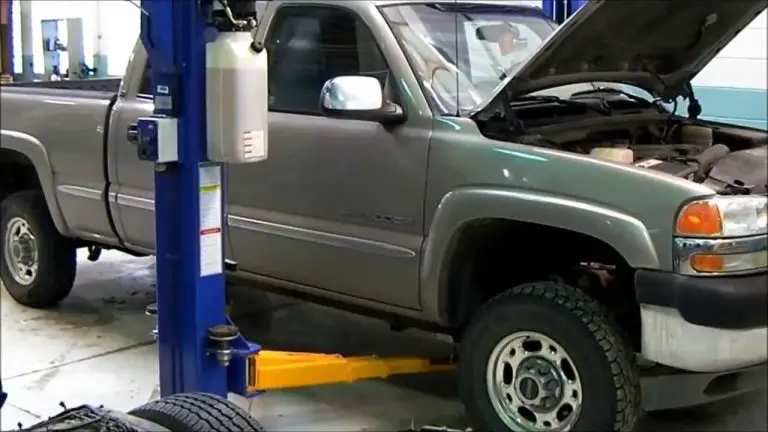Mastering the Art of Track Bar Adjustment: A Complete Guide
If you’re looking to improve your vehicle’s handling, one of the most crucial adjustments you can make is to your track bar. This small but influential component is responsible for keeping your wheels in line and your ride stable, so it’s essential to get it right. Adjusting your track bar might seem daunting, but with a little know-how and some basic tools, it’s a task that most DIY enthusiasts can handle.
In this step-by-step guide, we’ll walk you through the process of adjusting your track bar and explore the benefits that come with this simple yet effective upgrade. So, whether you’re a seasoned gearhead or a curious car owner, read on to discover everything you need to know about adjusting your track bar.
Gather the Tools You’ll Need
Adjusting the track bar on your vehicle can help improve your steering and handling, but before you begin, it’s important to gather the necessary tools. First and foremost, you’ll need a quality track bar wrench that fits the size of your adjustable track bar. You’ll also want to have a torque wrench on hand to ensure that you’re tightening the track bar to the proper specifications.
Additionally, you may require some lubricant to help loosen any rusted or stuck components. It’s also recommended to use a jack stand and wheel chocks to keep your vehicle stable while you work. By having all of these tools ready before you start, you’ll be able to adjust your track bar safely and effectively.
Remember, a properly adjusted track bar can help reduce body roll and improve overall stability, making for a safer and more comfortable driving experience.
Wrench Set
When you’re working on a project that requires a wrench, having the right set of tools is essential. It can be frustrating and time-consuming to start a project only to realize that you don’t have the right wrench sizes. So, before you begin, gather all the tools you’ll need.
The first thing you’ll need is obviously a wrench set. There are many different types of wrenches, including open-end wrenches, box-end wrenches, combination wrenches, adjustable wrenches, and more. Each type has its own unique strengths and weaknesses, so it’s essential to choose the right one for the job at hand.
Make sure you have all the necessary sizes as well. No two projects are alike, so a one-size-fits-all approach won’t work. An appropriately sized wrench will enable you to work more efficiently and save a lot of time and energy.
Remember that quality is essential when it comes to your wrench set. Don’t skimp on the cost, as cheap ones may not last and can cause more damage than good. Trust me; investing in a high-quality wrench set will be worth every penny and can last you a lifetime.

Jack Stands
If you’re planning on using jack stands to support your vehicle, there are a few tools you’ll need to gather beforehand. The most obvious ones are the jack stands themselves, which should be rated for the weight of your vehicle and have a wide enough base for stability. You’ll also need a jack, which will be used to lift the vehicle off the ground so you can position the stands.
It’s important to choose a high-quality jack that is also rated for the weight of your vehicle. A lug wrench or impact wrench is also necessary to remove the lug nuts from your tires. Additionally, it’s a good idea to have a pair of gloves on hand for protection and a flashlight or work light to help you see what you’re doing.
With these tools in hand, you’ll be ready to safely and securely use jack stands to maintain or repair your vehicle.
Torque Wrench
When it comes to working with torque wrenches, having the right tools on hand can make all the difference in the world. First and foremost, you’ll need the actual torque wrench itself. Make sure to select a model that matches the specific needs of your project and has a range of torque settings that can accommodate a variety of different bolt sizes.
Additionally, you’ll need a set of sockets that fit snugly onto your torque wrench, as well as a breaker bar or ratchet handle for loosening tight bolts. It’s also a good idea to have a few torque sticks on hand, which are designed to work with your torque wrench and prevent overtightening of bolts. By gathering all of these essential tools before you start your next project, you can feel confident that you have everything you need to get the job done quickly and effectively.
Locate the Track Bar
Adjusting the track bar on your vehicle is important for maintaining proper alignment and ensuring a smooth ride. To make this adjustment, you must first locate the track bar. Typically, it is a long, metal bar that runs parallel to your vehicle’s axles and connects to the frame.
You may need to consult your vehicle’s manual or do some online research to determine exactly where your track bar is located. Once you’ve located it, you can use a track bar relocation bracket to adjust the position of the bar. This allows you to correct any alignment issues and improve the stability of your vehicle on rough terrain.
Remember to take your time and be patient when making adjustments to your track bar. It’s better to make small, incremental changes and test your vehicle’s performance before making additional adjustments. By taking the time to properly adjust your track bar, you can ensure that your vehicle is operating at peak performance and prevent unnecessary wear and tear on your tires and suspension system.
Understand the Function of the Track Bar
When it comes to understanding the function of the track bar, the first step is to locate it. The track bar, also known as a panhard bar, is an essential component of your vehicle’s suspension system. It plays a crucial role in keeping your vehicle stable while driving, especially when making turns or going over uneven surfaces.
Typically, the track bar is located at the rear of the vehicle and runs parallel to the axle. It is attached to the frame on one end and the axle on the other. The purpose of this bar is to help keep the axle centered and prevent excessive lateral movement, which can cause handling issues, especially during high-speed driving or sudden maneuvers.
So, if you’re having problems with your vehicle’s handling or stability, it’s essential to check the track bar and ensure it’s in good condition.
Identify the Mounting Points of the Track Bar
To install a track bar on your vehicle, you need to first locate the mounting points of the track bar. The track bar, also known as a panhard bar, is a critical component of your vehicle’s suspension system that helps stabilize the body and keep the wheels centered during turns. Most vehicles have two mounting points for the track bar – one on the frame and the other on the axle or chassis.
To locate these mounting points, you may refer to the manufacturer’s manual or consult a professional mechanic. Once you have identified the mounting points, you can proceed to install the track bar and make any necessary adjustments to ensure proper alignment. It’s important to ensure that the track bar is properly installed and tightened to prevent any unwanted movement that could cause instability while driving.
With proper installation and maintenance, the track bar can enhance the overall handling and performance of your vehicle, providing a smoother and safer ride on the road.
Adjust the Track Bar
If you’re experiencing stability issues with your vehicle, you might need to adjust the track bar to fix the problem. The track bar is responsible for keeping the axle centered underneath the chassis, and any misalignment can cause handling problems. To adjust the track bar, first, locate the bolts at both ends of the bar and loosen them up.
Next, use a track bar bracket to align the bar with the centerline of the car and tighten the bolts back up. You may need to go through a trial and error process of adjusting the track bar and testing the car’s stability to get the perfect alignment. Adjusting the track bar can have a significant impact on your vehicle’s handling and overall ride quality, so it’s essential to get it right.
With a bit of patience and some careful adjustments, you’ll have your vehicle cruising smoothly and effortlessly in no time!
Loosen the Mounting Bolts
Loosen the mounting bolts when adjusting the track bar. This is an essential step that can’t be overlooked during routine maintenance or aftermarket upgrades. The track bar is an essential component in your steering and suspension system.
Its role is to keep the axle centered under the body as the suspension cycles up and down. A properly adjusted track bar is necessary to eliminate steering wander and uneven tire wear. As such, to adjust it, you need to loosen the mounting bolts.
This way, you can perform fine adjustments to center the axle underneath the frame. Failure to follow this step could lead to poor handling, and your track bar will not operate as intended. Therefore, it’s crucial to take this step seriously when working on your vehicle’s suspension.
Whether you’re a weekend DIY warrior or an experienced mechanic, always double-check to ensure you maintained the correct torque specifications once you’re done loosening the bolts.
Make the Necessary Adjustments
One of the key adjustments that can be made to a vehicle’s handling and performance is the track bar. This bar essentially helps to keep the axle centered and prevents side-to-side movement, which can have a significant impact on the vehicle’s stability. If you notice that your vehicle is swaying or feels unstable around turns, it may be time to adjust the track bar.
To make this adjustment, locate the track bar and use a wrench to loosen the bolts that hold it in place. Then, shift the bar left or right to achieve the desired level of stability and retighten the bolts. This simple adjustment can make a big difference in the overall handling of your vehicle, so don’t hesitate to give it a try if you’re experiencing any issues on the road.
Tighten the Mounting Bolts to the Proper Torque
If you’re planning to adjust the track bar for your vehicle, it’s essential to know how to tighten the mounting bolts to the proper torque. The torque specification has a significant impact on the performance of the vehicle. If the bolts are too loose, it can cause the track bar to move around, rattling and causing chaos on the road.
When the bolts are too tight, it can ruin the thread and eventually lead to breakouts. The best way to find the proper torque specifications for your vehicle is by referring to the owner’s manual. It’s important to keep in mind that the torque specifications may vary depending on the type of vehicle.
Once you have the correct specifications, use a torque wrench to tighten the bolts to the appropriate level. This will ensure that your track bar is securely fastened, and you can enjoy a safer and more stable ride.
Test and Inspect the Track Bar
Adjusting the track bar is an essential task in ensuring proper alignment of your vehicle’s suspension system. Before adjusting, the first step is to thoroughly inspect the track bar and check for any wear and tear. Begin by examining the bushings and the mounting brackets for any cracks or damage.
Also, inspect the bolts and ensure they are securely tightened. If there are any signs of wear, the track bar should be replaced. Once you have confirmed that the track bar is in good condition, you can proceed with adjusting it.
This is done by loosening the bolts and then using a jack to move the axle to the desired position. Keep in mind that adjusting the track bar will affect the vehicle’s ride height and alignment, so it is important to have the necessary tools and resources to perform the task correctly. A properly adjusted track bar will provide improved stability and handling, reducing the chances of accidents on the road.
Check the Alignment of the Vehicle
If you’re experiencing handling issues with your vehicle, one potential cause could be a misaligned or damaged track bar. This component is responsible for maintaining proper suspension and steering alignment. To test and inspect the track bar, start by checking for any visible damage or rust.
Next, check for any looseness in the connecting bolts or bushings. If everything looks okay, it’s time to take your vehicle on a test drive. Pay close attention to how the car handles and whether it pulls to one side or the other.
If you notice any issues, it’s important to have your track bar inspected and potentially replaced by a professional mechanic. By addressing any issues with your vehicle’s alignment, you can ensure a safer and smoother driving experience for yourself and your passengers.
Ensure the Track Bar is Installed Properly
The track bar is a crucial component of any vehicle’s suspension system, keeping its rear axle centered and stable. Therefore, it’s essential to ensure it’s installed correctly on your vehicle. To test and inspect the track bar, start by checking for any signs of wear or damage, such as cracks or bends.
Next, ensure that all mounting bolts and hardware are appropriately tightened to prevent any looseness or wobbling. You can also perform a visual check by verifying that the track bar is parallel to the driveshaft. If you notice any issues during your checks, you should consider replacing the track bar to avoid future problems.
Overall, ensuring that the track bar is installed correctly is crucial for keeping your vehicle safe on the road. By performing regular inspections and maintenance, you can prevent costly repairs and keep your car running smoothly.
Final Thoughts: Drive Safely with a Properly Adjusted Track Bar
If you want to ensure that you’re driving safely, it’s important to make sure that your track bar is properly adjusted. The track bar is an essential component of your vehicle’s suspension system, and if it’s not set up correctly, it can cause a variety of problems. Fortunately, adjusting the track bar isn’t too difficult of a process.
Firstly, you’ll need to make sure that your vehicle is parked on a level surface. Then, measure the distance between the frame and the track bar at the center of the vehicle, and adjust accordingly until it’s at manufacturer recommended settings. It’s important to note that if your track bar is too loose, it can cause excessive sway and instability when you’re driving.
On the other hand, if it’s too tight, it can make your ride feel uncomfortable and bumpy. So, to stay safe on the road, it’s crucial that you properly adjust your track bar. With a little bit of effort, you can ensure that your vehicle’s suspension system is working optimally and that you can avoid any potential mishaps that could occur because of improper adjustments.
Conclusion
Adjusting a track bar may seem like a daunting task, but with the right equipment and a little bit of know-how, it can be done in no time. Just remember, when adjusting your track bar, you’re not just improving your vehicle’s handling and stability – you’re also giving yourself the confidence to tackle whatever the road throws your way. So don’t be afraid to take on this important task, and in the words of the great mechanic Tim “The Tool Man” Taylor, “Let’s give this track bar a little more power, shall we?”
FAQs
What is a track bar in a car suspension system and why is it important to adjust it?
A track bar (also called a Panhard bar) is a suspension component that helps keep the rear axle centered under the car during turns and uneven roads. It’s important to adjust it to ensure proper handling and stability of the vehicle.
How do I know if my track bar needs adjustment?
Signs of a misaligned or worn track bar include uneven tire wear, excessive body roll during turns, and a feeling of instability or wandering while driving. A visual inspection can also reveal any damage or bend in the track bar.
Can I adjust the track bar myself, or do I need to take it to a mechanic?
Adjustment of the track bar requires precise measurements and specific tools, so it’s recommended to have a trained mechanic perform the task. Attempting to adjust it on your own can lead to further misalignment or damage to the suspension.
How often should the track bar be adjusted?
The track bar should be inspected for wear and alignment during routine maintenance, such as tire rotations or suspension inspections. Any signs of misalignment or wear should prompt an adjustment by a qualified mechanic.







